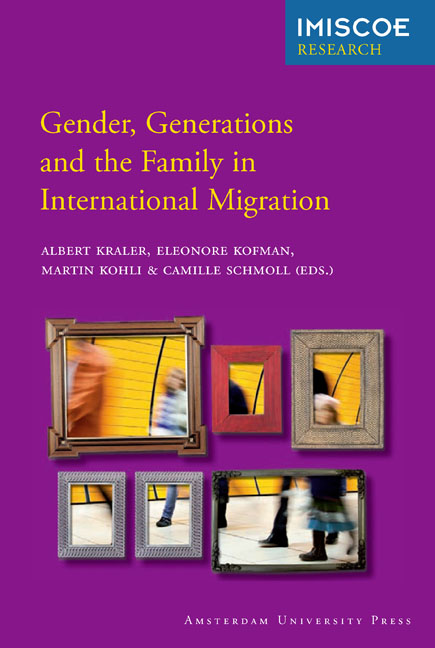Book contents
- Frontmatter
- Contents
- Preface
- 1 Introduction: Issues and Debates on Family-Related Migration and the Migrant Family: A European Perspective
- Section I The Family as a Moral and Social Order
- Section II Gender, Generation and Work in the Migrant Family
- Section III Marriage Migration and Gender Relations
- Section IV Transnational Family Lives and Practices
- List of Contributors
- Index
- Other IMISCOE titles
6 - The Problem of ‘Human Capital’: Gender, Place and Immigrant Household Strategies of Reskilling in Vancouver
Published online by Cambridge University Press: 21 January 2021
- Frontmatter
- Contents
- Preface
- 1 Introduction: Issues and Debates on Family-Related Migration and the Migrant Family: A European Perspective
- Section I The Family as a Moral and Social Order
- Section II Gender, Generation and Work in the Migrant Family
- Section III Marriage Migration and Gender Relations
- Section IV Transnational Family Lives and Practices
- List of Contributors
- Index
- Other IMISCOE titles
Summary
Introduction
During the past few decades, immigration policies across Europe have become more restrictive, with family-related migration as the most accessible and feasible mode to enter a country (on marriage migration in the Netherlands see Suksomboon this volume). In her chapter on Switzerland, Riaño (this volume) notes that the ratio of family-related immigration to labour immigration is high due to the fact that the government has traditionally controlled the latter more than the former. In contrast, as a largely immigrant-receiving country, Canada has increasingly developed an economic discourse that is highly restrictive in privileging the skilled economic immigrant over other immigrants seeking permanent residency. In 2006, Canada accepted 55 per cent of immigrants as economic class (primarily made up of skilled workers), 28 per cent as family class and 13 per cent as protected persons (refugees). The primary aim of the selection process is to admit skilled workers whose human capital will ensure they are flexible and self-sufficient and thereby ready to immediately contribute to the nation's economic goals. Such idealised immigrants are allowed to bring ‘dependent’ family members with them – spouses (or common-law partners) and dependent children – under strict eligibility conditions (Li 2003, 2004). In 2006, 44,163 skilled workers admitted as principal applicants were accompanied by 61,786 dependants. The majority (70 per cent) of primary applicants were men; 30 per cent were women (Citizenship and Immigration Canada 2007), indicating that the selection process is highly gendered.
In common with Europe (see e.g. all this volume Banfi & Boccagni; Bonizzoni, Evergeti & Ryan; Fleischer; Gonzalez-Ferrer), migration decisions to Canada are rarely individual but instead are primarily family and community strategies. Yet, the human capital discourse underlying Canada's selection process renders invisible the family members who accompany the principal immigrant and her or his relationship to social and economic outcomes. Canada's immigration policies and programmes give little recognition of how families contribute to integration and, indeed, tend to portray families as ‘burdens’ on the state and unworthy of support (Arat-Koc 1999; McLaren & Black 2005). If mentioned at all, immigrant families are frequently constructed as ‘problems’ to be effectively managed through state policies.
- Type
- Chapter
- Information
- Gender, Generations and the Family in International Migration , pp. 141 - 162Publisher: Amsterdam University PressPrint publication year: 2012
- 1
- Cited by



